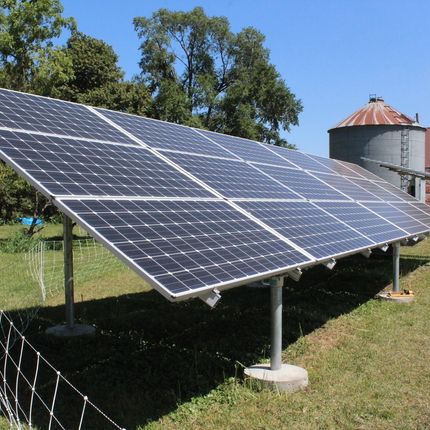By Nick Summers, former staff member
Solar energy has been on the rise for years. The industry has attracted massive amounts of investment, and the costs associated with the generation and distribution of solar energy have plummeted.
Solar energy offers affordable and reliable clean energy, tax revenue for local governments, and lease payments to landowners. When it is combined with vegetation that sequesters carbon, the economic and environmental benefits have the potential to increase.
In Iowa, an environmental consultant is testing out the effectiveness of sequestering carbon at a solar site. Mike Fisher received funding to test three different kinds of plant mixes: rye, prairie species, and a combination of flowers to see which most effectively sequesters carbon in the soil at a seven acre brownfield site in Perry. This solar site is owned by Alliant Energy, and they will receive any of the proceeds from selling the carbon that is sequestered onsite.
While there are a variety of practices that aim to sequester carbon into the soil, the method being tested by Fisher is the most compatible with an existing solar site. In fact, members of Congress and the Biden administration are making this form of carbon sequestration a key part of their plans to reduce greenhouse gas emissions. Carbon sequestration is beneficial to soil health and water quality, as well as helping to reduce erosion. Native vegetation can also be an effective habitat to local wildlife, such as pollinators.
The stackable benefits of solar energy projects and carbon sequestration could be a boon to farmers and the rural communities in which they live. Lease payments from the solar sites and the proceeds from the sale of the carbon credits would go to the landowner and the tax revenue would go to the local community. Environmental benefits, such as improved water quality, protected soil, and sequestered carbon, combined with the clean energy produced by the solar array benefit local ecosystems, reduce carbon emissions, and provide affordable solar energy.
The carbon credits represent established quantities of sequestered carbon which can be sold on private markets to emitters who wish to use carbon offsets to reduce their carbon footprint. There are currently a multitude of voluntary private markets for carbon credits with various price points ranging from a few cents per metric ton of carbon dioxide emissions to $15-20 per metric ton. This system could become more reliable and the price could increase if Congress subsidizes sequestered carbon and if legislation like the Growing Climate Solutions Act is passed. This bill seeks to create a USDA program that would lower the barriers to entry into voluntary carbon credit markets for farmers and ranchers. It would also certify those that seek to offer technical assistance in developing these projects and those that wish to become third-party verifiers for credits sold in these markets. Amplifying the value of solar sites with carbon sequestration projects can be a net boon for the people whose land and communities house them.





